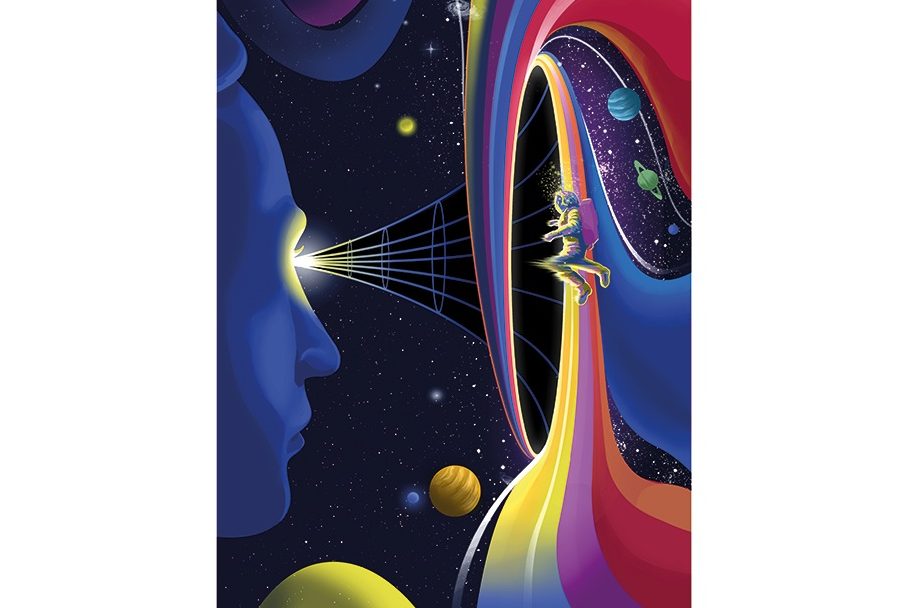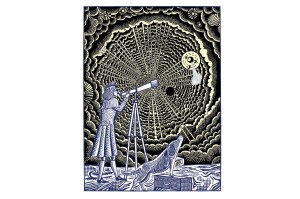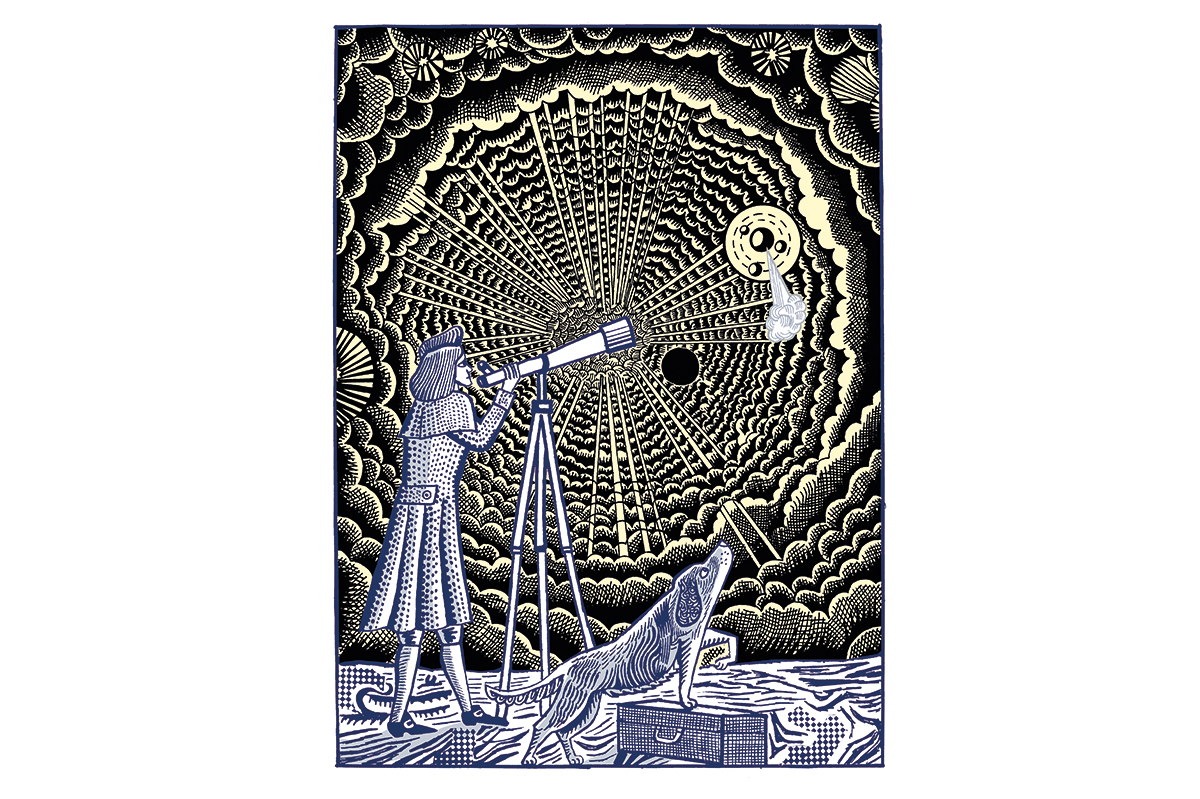One thing upon which my friend Jeremy Clarke and I always agreed is the value of seeing the world from different points of view. In that sense we partially agreed on everything. This essential skill needs to be learned and I assert that nature is a wonderful teacher. Perhaps the most surprising and bamboozling example can be found in the study of black holes.
Here are two apparently contradictory properties of black holes. When viewed from the outside, time stops on the event horizon — the boundary that marks the black hole’s edge, beyond which light cannot escape — and anyone attempting to cross into the interior would be seen frozen there forever. From the perspective of an astronaut falling into a supermassive black hole, however, nothing unusual happens as she travels across the horizon and into the interior, although she would be trapped in a flowing river of space carrying her to oblivion.
At the heart of the black hole lies the singularity. It is tempting to picture this as an infinitely dense point in space. More correctly, it should be viewed as a moment in time — the end of time, according to Einstein’s theory, because it lies inexorably in the future of all those who cross the event horizon, just as tomorrow lies inexorably in your future. This was known to physicists before anyone had ever observed a black hole. If it all sounds confusing, you are in good company. Einstein’s contemporary, Sir Arthur Eddington, commented that “there should be a law of nature to prevent stars from behaving in this absurd way.” Well, there isn’t, they do and we must face the consequences.
If the countless black holes are cosmic erasers that delete information, we need a radical rethink
In the early 1970s, a series of papers, including the evocatively titled “Black Hole Explosions” by Stephen Hawking, laid the foundations for a fifty-year intellectual struggle known as the black hole information paradox. The paradox concerns the fate of things that cross the horizon and, according to the Einsteinian picture, meet their fate at the end of time. The problem uncovered by Hawking is that black holes do not live forever. Using the other great pillar of twentieth-century physics — quantum theory — Hawking showed that black holes glow, albeit extremely faintly. So important was this discovery that Hawking’s equation for the temperature of a black hole is now chiseled on his memorial stone on the floor of Westminster Abbey. The essential point is that anything that glows must lose energy and therefore shrink, and Hawking’s calculation showed that a black hole gets hotter and hotter as it shrinks until, one day in the far future, it vanishes, leaving only Hawking radiation behind.
The paradox occurs because, according to Hawking’s calculation, the radiation that remains is devoid of all information; it is as featureless as it is possible to be. The implication is that no trace of anything that ever fell into the black hole is left when the black hole has gone. But — and here is the paradox — according to quantum theory, information is never destroyed. Leonard Susskind, one of the pioneers of black hole physics, wrote in his memoir The Black Hole War: “Stephen claimed that information is lost in black hole evaporation… if this was true, the foundations of our subject [physics] were destroyed.” The reason he, and pretty much everyone else, was worried about information loss is that all the known laws of physics are deterministic. If we know everything there is to know about something — the universe, for example — then we expect to be able to calculate what that thing was doing in the past and what it will do in the future. This is what we mean by determinism. But if the countless millions of black holes that populate the universe are cosmic erasers that delete information, we need a radical rethink.
The outline of a solution to this existential challenge to physics has been discovered over the last few years, and it has (and I write this without casual hyperbole) profound consequences for our picture of reality.
Let’s return to an astronaut diving across the horizon and into the black hole. From her perspective she crosses the horizon and approaches the singularity, but before she arrives, she is “spaghettified” — ripped apart and scrambled into her atomic constituents by powerful gravitational tidal forces. At this point, Einstein’s theory breaks down as space and time dissolve away in unfathomable violence. When Hawking’s quantum calculations are added to the mix, however, a different picture emerges. If a colleague watches from afar, he concludes that his intrepid friend was vaporized by highly energetic Hawking radiation before she crossed the horizon. Which picture is correct? Is the astronaut spaghettified or vaporized? We now believe that both views are valid. This wild idea is known as black hole complementarity. Let us call it a Third Way.
In 2019, two groups proved that Hawking’s 1975 calculation was incomplete, and all the information contained in everything that fell into a black hole throughout its lifetime ends up imprinted in the Hawking radiation. Key to this discovery was the realization that the inside of the black hole is, in a sense we don’t yet understand, the same place as the outside. One speculative picture holds that the singularity can be seen as a tangled mass of quantum wormholes connecting the interior of the black hole to far-distant regions of space and time outside the event horizon. Whatever the explanation, the outcome is the same. The astronaut is spaghettified from one perspective and vaporized from another, but either way the information about the astronaut ends up imprinted in the Hawking radiation. Reality may be strange, but it is logically consistent.
This “dual” picture — two radically different and yet equivalent views of reality — hints that space and time as we perceive them are not fundamental properties of the universe. It seems that they emerge from, to borrow another phrase from Einstein, something deeply hidden — a quantum theory in which there is no space and no time. And, in an intriguing twist, it appears our reality may be encoded in the underlying quantum theory using a method that computer scientists have discovered that allows for information to be encoded in the memory of quantum computers in an error-tolerant way. I do not think this is evidence we live in a simulation, but it does suggest our universe behaves like a quantum computer. In the twentieth century, one might have concluded that God is a mathematician. A twenty-first-century understanding suggests “The Old One” may be a computer geek.
Wherever this research leads, the lesson from nature is clear. Looking at a thing from different points of view is not a luxury but a necessity if we aspire to develop a deep understanding. And I assert that this is a universal truth, whether one’s interest is in understanding black holes or running a country.
This article was originally published in The Spectator’s UK magazine. Subscribe to the World edition here.


























Leave a Reply